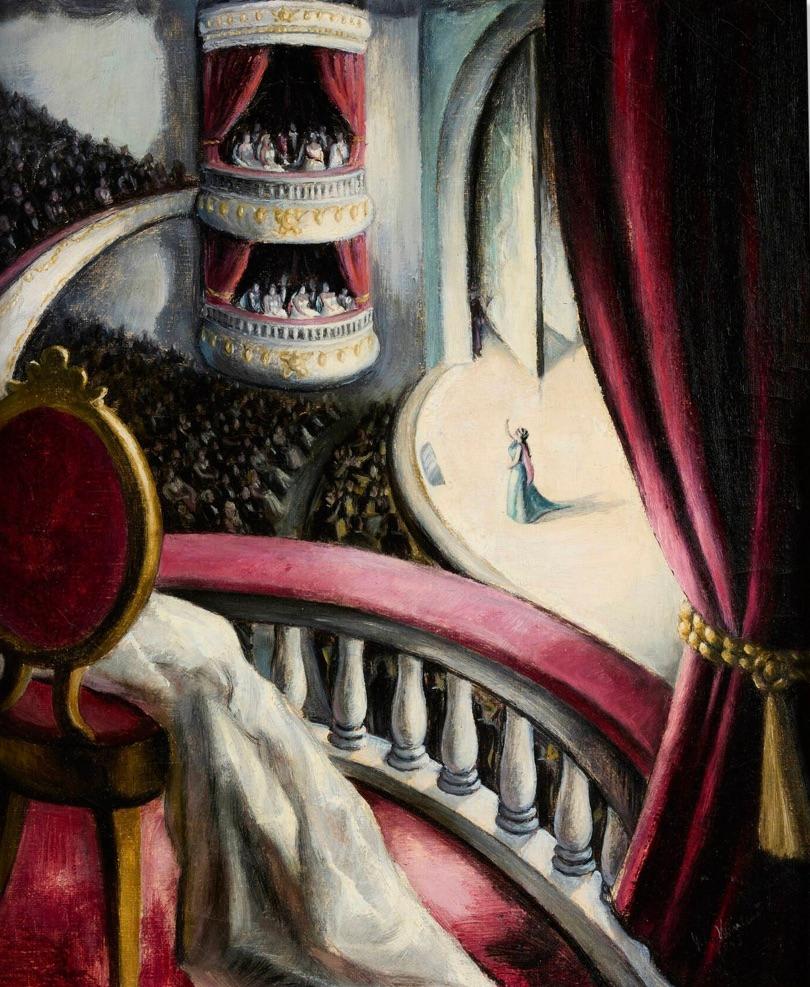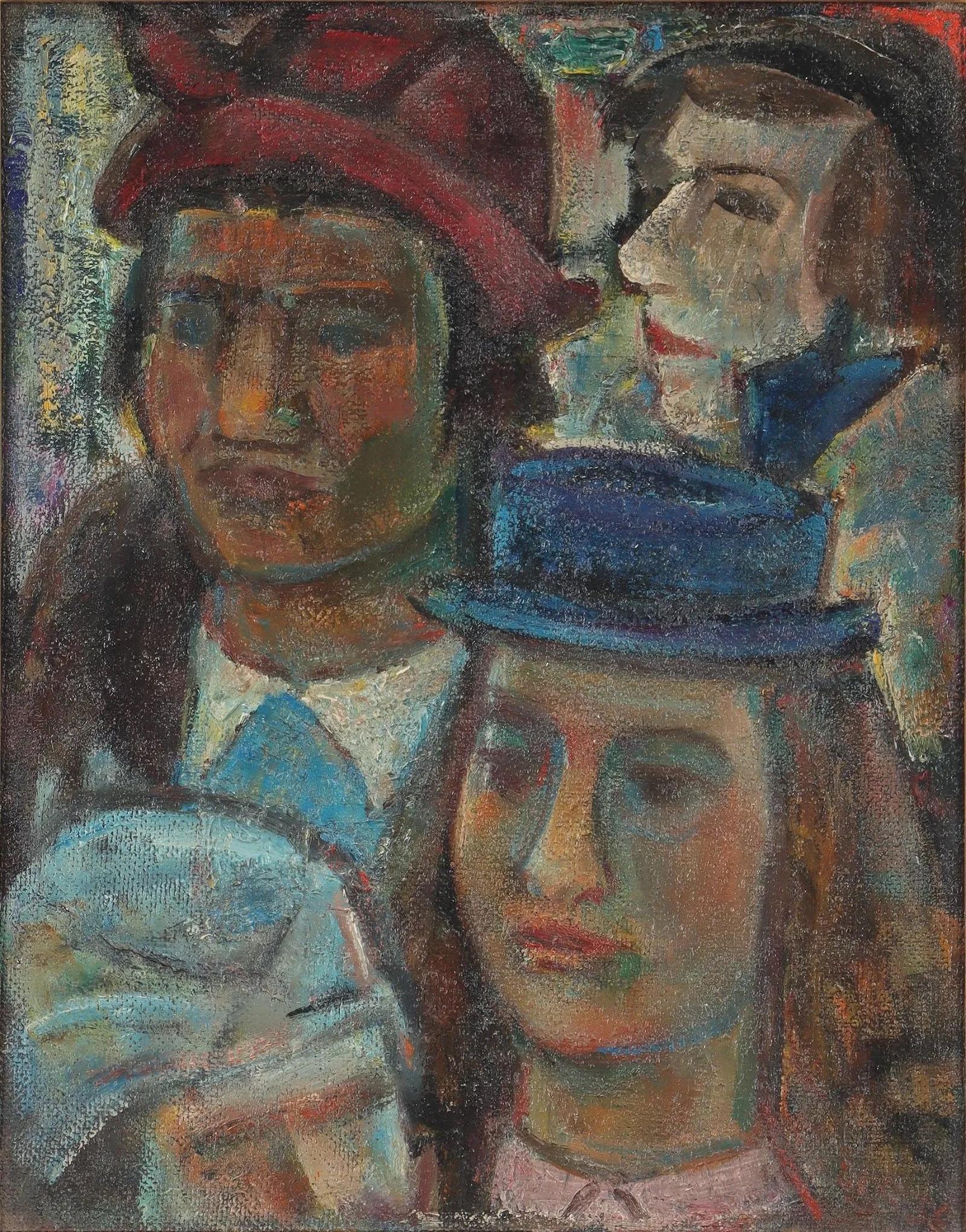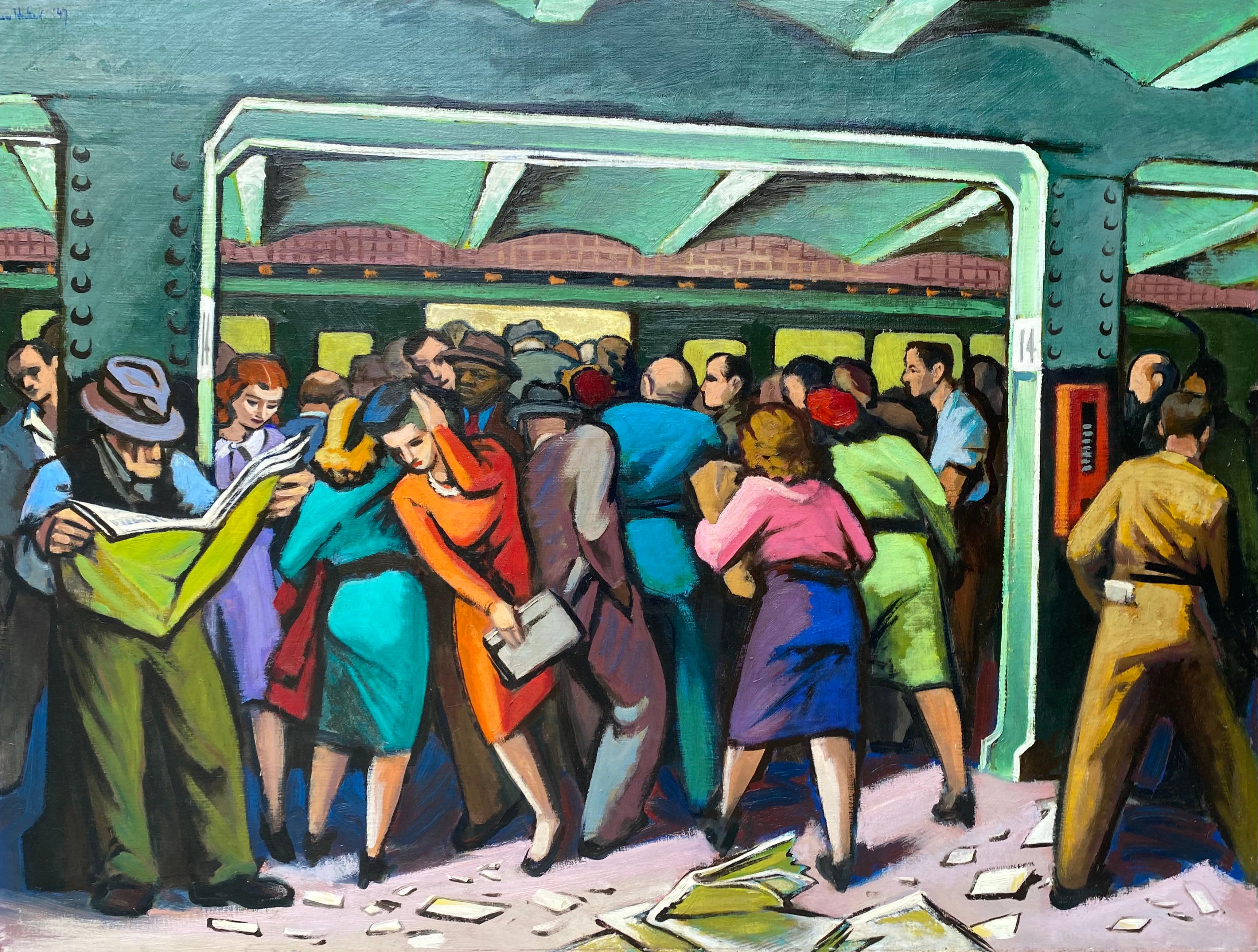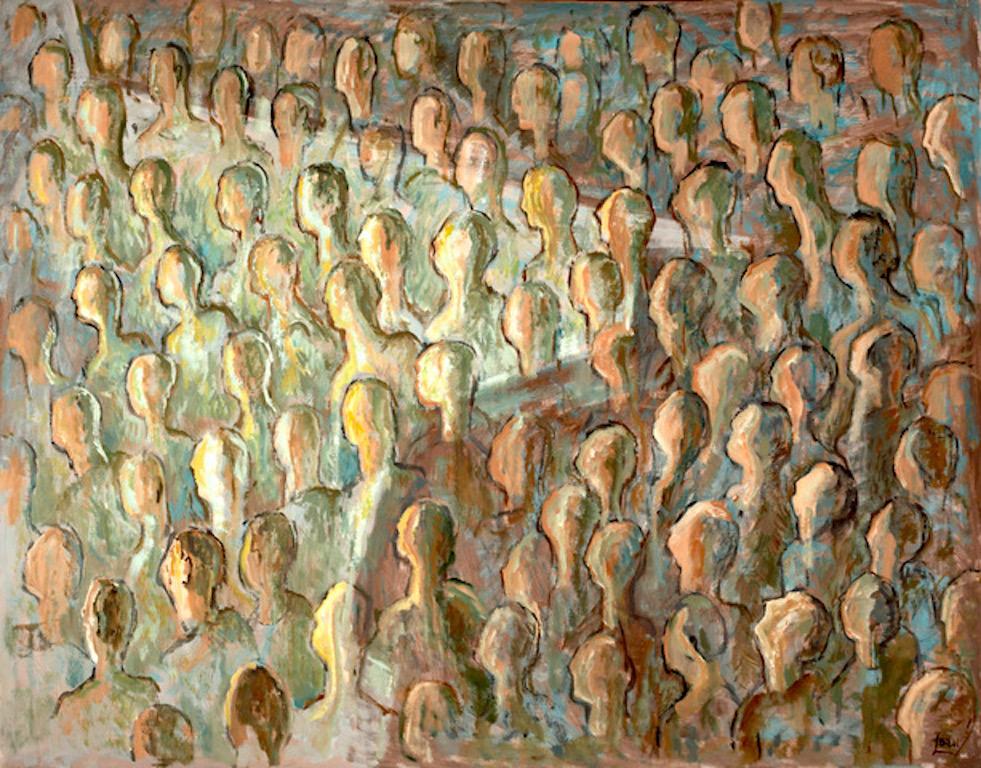Items Similar to San Pedro Post Office: History of Writing Mural South, Preliminary Mural Study
Want more images or videos?
Request additional images or videos from the seller
1 of 5
Edward BibermanSan Pedro Post Office: History of Writing Mural South, Preliminary Mural Studyc. 1936-7
c. 1936-7
About the Item
This mural study is part of our exhibition America Coast to Coast: Artists of the 1930s
San Pedro Post Office: History of Writing Mural South, Preliminary Mural Maquette right panel, 1936-7 mixed media on paper mounted on masonite, 20 x 41 inches (image), 30 x 52 inches (framed); exhibited in Lost Horizons: Mural Dreams of Edward Biberman, Los Angeles County Museum of Art at SPARC's Duron Gallery from May 31 to August 29, 2014; illustrated in i) the catalog for the foregoing p. 22; and ii) (film) Kaufman, Jeffrey, Brush with Life: The Art of Being Edward Biberman, 2007, (DVD release 2010), 85 minutes; provenance estate of the artist; presented in newer frame from the 2014 LACMA/SPARC exhibition
About the Painting
Even before the creation of the WPA and the Treasury Department Section of Fine Arts, Biberman was known as a mural painter, having been selected for inclusion in one of the Museum of Modern Art’s early exhibitions in 1932, Murals by American Painters and Photographers. Around the same time, he also joined the National Society of Mural Painters. While in New York, Biberman lectured on muralism, taught classes on mural techniques and knew, admired, and drew lessons from Los Tres Grandes, the Mexican muralists, Orozco, Rivera, and Siqueiros. By his own reckoning, Biberman competed for seven or eight Federal Government mural projects during the 1930s and early 1940s. In addition to the San Pedro Post Office for which the present works were completed, Biberman submitted designs for the Rincon Annex Post Office (San Francisco), Department of the Interior Building (Washington, DC), the Recorder of Deeds Building (Washington, DC), and the St. Louis Post Office (St. Louis, Missouri), as well as projects in New Jersey and Dallas, Texas. Although Biberman did not win these competitions, he was awarded three Federal Government mural commissions based on being the runner up in several prior efforts. Biberman also served as a member of the jury for the national competition for the Social Security Building in Washington DC where he was able to reconnect with leaders of the Treasury Section of Fine Arts, including Edward Bruce, Edward Beatty Rowan, George Biddle, Holger Cahill and Forbes Watson. Biberman’s completed projects were a wall mural showcasing the history of Los Angeles for the Federal Building in Los Angeles, a ceiling mural for the same building depicting the contributions of four ethnic groups to the development of California, and his best-known mural, Abbott Kinney and the Story of Venice, for the Venice Post Office.
In October, 1936, the Treasury Department Section of Fine Arts announced the competition for the San Pedro California Post Office mural project. The request for submissions noted that the winning artist would receive the handsome sum of $4,900 for the 74-foot long mural. For his entry, Biberman explored the global history of written communication from message sticks through the printing press. In addition to his artistic skills, Biberman was a proficient writer and even better speaker. Words mattered deeply, so Biberman's selection of subject matter is unsurprising, as is his depictions of the contributions of earlier cultures from around the world. Native American peoples had played important parts in his completed mural for the Los Angeles Federal Building, as well as his submissions for the Department of the Interior Building and the Rincon Annex Post Office in San Francisco. Biberman's depiction of less well known forms of written communication such as marked pebbles likely was the result of his interest in historical research and his desire to deeply immerse himself in his mural submissions. "I got very excited by the work" Biberman recalled, "the research, let me say, proved to be one of the most fruitful areas of all of these jobs." Biberman was one of seventy-seven artists to submit designs and his friend and fellow Angelino, Fletcher Martin, won the commission for his designs portraying the history of mail delivery, which can still be seen today.
The Los Angeles County Museum of Art (LACMA), in cooperation with SPAC, hosted a 2014 retrospective of Biberman’s mural-related art at the Duron Gallery, which included all of Biberman's existing designs for the San Pedro Post Office, including this work. This show ran concurrently with LACMA’s other exhibition, Edward Biberman, Abbot Kinney and the Story of Venice, where the Abbott Kinney mural was displayed.
About the Artist
Edward Biberman was born in Philadelphia, the son of Ukrainian Jewish immigrants. His artistic career started at the Pennsylvania Academy of Fine Arts followed by three years of study in Paris, where he associated closely with Calder and Noguchi and exhibited at the Salon d'Automne, Grand Palais, in 1927 and the Salon des Independents in 1929. Upon his return to the United States, Biberman spent time in New York City, where he showed at many of the city’s premier galleries and museums. His works were selected for several of the Museum of Modern Art’s early exhibitions of American artists, including 46 Painters and Sculptors Under the Age of 35 (1930) and Murals by American Painters and Photographers (1932). Hoping to escape the pressures of the New York art world, Biberman moved to Los Angeles in 1936 where he could be close to his family, including his film director brother, Herbert Biberman, and his sister-in-law, the Academy Award winning actress, Gale Sondergaard.
During the course of his long career, Biberman showed at the Salon d’Automne (Paris); Whitney Museum; Metropolitan Museum of Art, Museum of Modern Art, Corcoran Gallery, Los Angeles County Museum of Art (LACMA) and dozens of other museums and galleries across the US and in Europe. Biberman completed three murals for public works projects, including his work Abbot Kinney and the Story of Venice for the Venice Post Office, which was installed for six months at LACMA in 2014. His works are in the permanent collections of more than a dozen museums, including the National Portrait Gallery (of the Smithsonian Institution), Los Angeles County Museum of Art, Museum of Fine Arts, Houston, Butler Institute of American Art, and Pennsylvania Academy of Fine Arts. Several books are dedicated to Biberman’s art, as is a feature length documentary, Brush with Life: The Art of Being Edward Biberman (2007). Biberman’s art has undergone a resurgence of popularity during the past fifteen years with four solo or focused exhibitions, Edward Biberman Revisited (2009), Edward Biberman (2011-12), Lost Horizons: Mural Dreams of Edward Biberman (2014) and Edward Biberman, Abbot Kinney and the Story of Venice (2014), and representation in a number of other exhibitions, such as To Make a World: George Ault and 1940s America at the Smithsonian Institution and other institutions (2011), Pacific Standard Time (2012), Contraption: Rediscovering California Jewish Artists (2018),Black American Portraits (2021) at LACMA, Encounters in American Realism (2022) at The Westmoreland Museum of American Art and Art for the People WPA Paintings from the Dijkstra Collection (2023) at the Crocker Art Museum (Sacramento, CA), Oceanside Museum o f Art (Oceanside, CA) and The Huntington Library, Art Museum and Botanical Gardens (San Marino, CA).
Biberman’s brand of modernism can fairly be divided into four categories 1) precisionist urban scenes of New York and Southern California which celebrate the creations of humanity; 2) portraits which expose not only the historical context, but also the souls, of his subjects; 3) rural landscapes and still life paintings which portray the beauty of America and its flora; and 4) social realist works which explore the struggles, hopes and shortcomings of our society. Regardless of genre, Biberman had a unique sense of structure and color. His figures are at the same time specific and universal. Taken as a whole, Biberman’s body of work presents the viewer with a compelling and often daring vision of 20th century America and its art.
- Creator:Edward Biberman (1904 - 1986)
- Creation Year:c. 1936-7
- Dimensions:Height: 20 in (50.8 cm)Width: 41 in (104.14 cm)Depth: 1 in (2.54 cm)
- More Editions & Sizes:20 x 41Price: $27,500
- Medium:
- Movement & Style:
- Period:
- Condition:
- Gallery Location:Los Angeles, CA
- Reference Number:1stDibs: LU1859213056692
About the Seller
No Reviews Yet
Vetted Seller
These experienced sellers undergo a comprehensive evaluation by our team of in-house experts.
1stDibs seller since 2022
6 sales on 1stDibs
Typical response time: 3 hours
- ShippingRetrieving quote...Ships From: Los Angeles, CA
- Return PolicyA return for this item may be initiated within 3 days of delivery.
More From This SellerView All
- What a LifeLocated in Los Angeles, CAWhat a Life, c. 1930, mixed media on board, 18 x 24 inches, signed lower left; titled on label; exhibited at The San Francisco Art Association Fifty-Second Annual Exhibition at the P...Category
1920s American Modern Figurative Paintings
MaterialsMixed Media
- Quarry WorkersLocated in Los Angeles, CAThis painting is part of our exhibition America Coast to Coast: Artists of the 1930s Quarry Workers, c. 1930s, mixed media on board, unsigned, 24 x 24 inches, possibly exhibited at...Category
1930s American Modern Figurative Paintings
MaterialsMixed Media
- Six O'ClockLocated in Los Angeles, CASix O-Clock, c. 1942, oil on canvas, 30 x 20 inches, signed and titled several times verso of frame and stretcher (perhaps by another hand), marked “Rehn” several times on frame (for the Frank K. M. Rehn Galleries in New York City, who represented Craig at the time); Exhibited: 1) 18th Biennial Exhibition of Contemporary American Oil Paintings from March 21 to May 2, 1943 at The Corcoran Gallery of Art in Washington, D.C. #87, original price $450 (per catalog) (exhibition label verso), 2) Craig’s one-man show at the Frank K. M. Rehn Galleries, New York City, from October 26 to November 14, 1942, #10 (original price listed as $350); and 3) Exhibition of thirty paintings sponsored by the Harrisburg Art Association at the State Museum of Pennsylvania in Harrisburg in March, 1944 (concerning this exhibit, Penelope Redd of The Evening News (Harrisburg, Pennsylvania) wrote: “Other paintings that have overtones of superrealism inherent in the subjects include Tom Craig’s California nocturne, ‘Six O’Clock,’ two figures moving through the twilight . . . .” March 6, 1944, p. 13); another label verso from The Museum of Art of Toledo (Ohio): original frame: Provenance includes George Stern Gallery, Los Angeles, CA About the Painting Long before Chris Burden’s iconic installation outside of the Los Angeles County Museum of Art, Urban Light, another artist, Tom Craig, made Southern California streetlights the subject of one of his early 1940s paintings. Consisting of dozens of recycled streetlights from the 1920s and 1930s forming a classical colonnade at the museum’s entrance, Burden’s Urban Light has become a symbol of Los Angeles. For Burden, the streetlights represent what constitutes an advanced society, something “safe after dark and beautiful to behold.” It seems that Craig is playing on the same theme in Six O-Clock. Although we see two hunched figures trudging along the sidewalk at the end of a long day, the real stars of this painting are the streetlights which brighten the twilight and silhouette another iconic symbol of Los Angeles, the palm trees in the distance. Mountains in the background and the distant view of a suburban neighborhood join the streetlights and palm trees as classic subject matter for a California Scene painting, but Craig gives us a twist by depicting the scene not as a sun-drenched natural expanse. Rather, Craig uses thin layers of oil paint, mimicking the watercolor technique for which he is most famous, to show us the twinkling beauty of manmade light and the safety it affords. Although Southern California is a land of natural wonders, the interventions of humanity are already everywhere in Los Angeles and as one critic noted, the resulting painting has an air of “superrealism.” About the Artist Thomas Theodore Craig was a well-known fixture in the Southern California art scene. He was born in Upland California. Craig graduated with a degree in botany from Pomona College and studied painting at Pamona and the Chouinard Art School with Stanton MacDonald-Wright and Barse Miller among others. He became close friends with fellow artist Milford Zornes...Category
1940s American Modern Landscape Paintings
MaterialsCanvas, Oil
- Subway ConstructionLocated in Los Angeles, CAThis painting is part of our exhibition American Coast to Coast: Artists of the 1930s Subway Construction, c. 1928, oil on board, 19 x 15 ¾ inches, signed upper left, artist and title verso; exhibited: 1) 12th Annual Exhibition of the Society of Independent Artists, The Waldorf Astoria, New York NY, from March 9 to April 1, 1928, no. 864 (original price $250) (see Death Prevailing Theme of Artists in Weird Exhibits, The Gazette (Montreal, Quebec, Canada), March 8, 1928); 2) Boston Tercentenary Exhibition Fine Arts and Crafts Exhibition, Horticultural Hall, Boston MA, July, 1930, no. 108 (honorable mention - noted verso); 3) 38th Annual Exhibition of American Art, Cincinnati Art Museum, Cincinnati, OH, June, 1931 (see Alexander, Mary, The Week in Art Circles, The Cincinnati Enquirer, June 7, 1931); and 4) National Art Week Exhibition [Group Show], Montross Gallery, New York, New York, December, 1940 (see Devree, Howard, Brief Comment on Some Recently Opened Exhibitions in the Galleries, The New York Times, December 1, 1940) About the Painting Ernest Stock’s Subway Construction depicts the excavation of New York’s 8th Avenue line, which was the first completed section of the city-operated Independent Subway System (IND). The groundbreaking ceremony was in 1925, but the line did not open until 1932, placing Stock’s painting in the middle of the construction effort. The 8th Avenue line was primarily constructed using the “cut and cover” method in which the streets above the line were dug up, infrastructure was built from the surface level down, the resulting holes were filled, and the streets reconstructed. While many artists of the 1920s were fascinated with the upward thrust of New York’s exploding skyline as architects and developers sought to erect ever higher buildings, Stock turned his attention to the engineering marvels which were taking place below ground. In Subway Construction, Stock depicts workers removing the earth beneath the street and building scaffolding and other support structures to allow concrete to be poured. Light and shadow fall across the x-shaped grid pattern formed by the wooden beams and planks. It is no surprise that critics reviewing the painting commented on Stock’s use of an “interesting pattern” to form a painting that is “clever and well designed.” About the Artist Ernest Richard Stock was an award-winning painter, print maker, muralist, and commercial artist. He was born in Bristol, England and was educated at the prestigious Bristol Grammar School. During World War I, Stock joined the British Royal Air Flying Corps in Canada and served in France as a pilot where he was wounded. After the war, he immigrated to the United States and joined the firm of Mack, Jenny, and Tyler, where he further honed his architectural and decorative painting skills. During the 1920s, Stock often traveled back and forth between the US and Europe. He was twice married, including to the American author, Katherine Anne Porter. Starting in the mid-1920s, Stock began to exhibit his artwork professionally, including at London’s Beaux Arts Gallery, the Society of Independent Artists, the Salons of America, the Cincinnati Art Museum, the Whitney Studio and various locations in the Northeast. Critics often praised the strong design sensibility in Stock’s paintings. Stock was a commercial illustrator for a handful of published books and during World War II, he worked in the Stratford Connecticut...Category
1920s American Modern Figurative Paintings
MaterialsOil
- Gold Mine, Central City, ColoradoBy Joseph MeertLocated in Los Angeles, CAThis painting is part of our exhibition America Coast to Coast: Artists of the 1930s Goldmine, Central City, Colorado, oil on canvas, 36 x 28 inches, c. 1936, signed lower right, ex collection of Platt Fine Art, Chicago, Illinois (label verso). About the Painting Joseph Meert’s painting, Goldmine, Central City, Colorado, depicts the short-lived resurrection of a once prominent city just outside Denver. Central City was founded in 1859 soon after John Gregory struck gold in the area. As word spread, thousands of miners converged into “Gregory’s Gulch” and its surroundings became known as the “richest square mile on earth.” Mining production quickly increased resulting in Central City to becoming Colorado’s largest city in the early 1860s. Despite some technical difficulties transitioning to lode mining and the rise of competition from Leadville, Central City remained an economic boom town through the turn of the century. But, with every boom, there is a bust. World War I marked the end of Central City’s prominence as ore production ground to a halt and by 1925, the town’s population shrank to only 400 people. The desperation of the Great Depression and a nearly 100% increase in the price of gold lured labor and capital back to Central City. Meert painted in Colorado during the mid-1930s, a time when he created his most desirable works. It is during this period of renaissance that Meert captures one of Central City's outlying dirt streets bordered by 19th century wooden houses from the town's heyday and the more recently installed electric lines leading to a distant gold mine. A lone figure trudges up the hill, a mother with a baby in her arms, putting us in mind of the rebirth of the town itself. Meert had solo exhibitions at the Colorado Springs Fine Arts Center in 1936 and the Denver Art Museum. Although it is not known whether Goldmine, Central City was included in either of these exhibitions, it seems likely. Moreover, the painting is closely related to Meert’s painting, The Old Road, which was painted in 1936 and exhibited at the Corcoran Gallery of Art in Washington, DC and at the Dallas Museum of Art. About the Artist Joseph Meert was a well-regarded painter and muralist, who initially made a name for himself in the American Scene and later as an abstract expressionist. Although initially successful, Meert struggled financially and with mental illness later in life. He was born in Brussels, Belgium, but moved with his family to Kansas City, Missouri. As a child, a chance encounter at the Union Pacific Railyard changed his life. Meert happened upon a worker repainting and stenciling a design on a railroad car. Meert later recalled that this experience introduced him to the idea of being a painter. Without support from his father, Meert obtained a working scholarship to the Kansas City Art Institute. After four years at the Kansas City Art Institute, Meert studied seven years at the Art Students League and in Europe and Los Angeles. At the Art Students League, Meert fell under the spell of Thomas Hart Benton and Stanton MacDonald-Wright. In 1931, he befriended Jackson Pollock. By 1934, Meert was part of the Public Works of Art Project when he met his wife, Margaret Mullin...Category
1930s American Modern Landscape Paintings
MaterialsCanvas, Oil
- Fallen Comrades/InterludeLocated in Los Angeles, CAThis work is part of our exhibition - America Coast to Coast: Artists of the 1940s Fallen Comrades/Interlude, 1949, oil on masonite, signed lower left, 35 x 56 inches; Gallery Z la...Category
1940s American Modern Paintings
MaterialsMasonite, Oil
You May Also Like
- Seated FigureLocated in Rockland, MESally Michel Biography American, 1902-2003 Sally Michel Avery was an American painter known for her lyrical depictions of everyday life. Though she used techniques and stylized form...Category
1980s American Modern Figurative Paintings
MaterialsOil
- "At the Opera" WPA Social Realism Mid 20th Century Modern Theatre American SceneLocated in New York, NY"At the Opera" WPA Social Realism Mid 20th Century Modern Theatre American Scene John Winters (1904 - 1983) "At the Opera" 17 x 14 inches oil on canvas Signed and dated 1943 lower r...Category
1940s American Modern Interior Paintings
MaterialsCanvas, Oil
- Neon Lighting WPA Mid 20th Century Social Realism American Scene Modern FiguresBy Maurice BeckerLocated in New York, NYMAURICE BECKER (1889-1975) 'Neon Lighting 17 1/4 x 13 3/4 inches Oil on masonite Signed, dated 1936 and titled on verso BIO Maurice Becker, painter, political cartoonist and social reformer, was born in 1889 either in Gorky or Niznij Novgorod, in Russia. His family came to the United States in 1892, to New York City. After high school, Becker worked in a clothing factory. He studied with Ash Can School artist Robert Henri in 1908, and exhibited in the famous 1913 Armory Show in New York City when he was only twenty-four years of age. At the Armory show, Becker showed a drawing of a dog's head...Category
1930s American Modern Figurative Paintings
MaterialsOil, Masonite
- "Sock Hop" Mid-Century American Modernism WPA Female Artist 20th Century RealismBy Kyra MarkhamLocated in New York, NY"Sock Hop" Mid-Century American Modernism WPA Female Artist 20th Century Realism. 30 x 24 inches. Oil on canvas. Signed on stretcher, c. 1940s. Frame is likely original to the painting. Realist painter-printmaker Kyra Markham...Category
1940s American Modern Figurative Paintings
MaterialsOil, Canvas
- NYC Subway Mid 20th Century American Modernism WPA Realism industrial ColorfulLocated in New York, NYNYC Subway Mid 20th Century American Modernism WPA Realism industrial Colorful "New York Subway," 36 x 48 inches. Oil on Masonite (backed with a wood frame), Signed and dated ’47 upper left. The colors of the painting are extraordinarily vibrant. The white gold frame, signed Richard Tobey...Category
1940s American Modern Figurative Paintings
MaterialsMasonite, Oil
- "Audience" Mid 20th Century American Figurative Theatre Performance ContemporaryBy Leon BibelLocated in New York, NY"Audience" Mid 20th Century American Figurative Theatre Performance Contemporary Leon Bibel (1912 - 1995) "The Audience," 52 ½ x 41 ¼ inches. Oil on canvas, c. 1963. Signed lower right. Framed. BIO Painter, printmaker and sculptor, Leon Bibel was born in San Francisco in 1913. He trained at the California School of Fine Arts and received a scholarship to study under the German Impressionist Maria Riedelstein. He worked in collaboration with Bernard Zackheim, a student of Diego Rivera, to create frescoes for the San Francisco Jewish Community Center and the University of California Medical School. In 1936 Bibel moved from California to join the Federal Art Project at Harlem Art...Category
1960s American Modern Figurative Paintings
MaterialsCanvas, Oil




